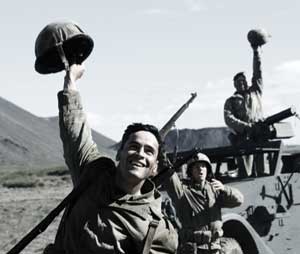WAVE OF FABRICATION

When AP photographer Joe Rosenthal captured six soldiers erecting a pole in mountainous terrain during the U.S. military’s successful battle to overtake an isolated Japanese stronghold in 1945, the Pulitzer Prize-winning image was a mythological goldmine. “Raising the Flag on Iwo Jima” became an essential ode to American patriotism, flaunting the country’s insignia as national agitprop with smug triumphalism bested only by George Washington’s emblematic crew crossing the Delaware. Rosenthal’s picture fielded more critical eyes early on, but accusations of theatricality were moot.
Clint Eastwood’s Flags of Our Fathers makes no apologies for its status as a dramatization. An innately compelling war saga, it celebrates World War II iconography and critiques its exploitation in the American government. The script, by Paul Haggis and William Broyles, Jr., draws from James Bradley’s book of the same title, which demystified the lives of the Iwo Jima flag raisers (one of which was his father). The central themes deal with small men and big politics: Following the publication of the photograph, the White House glorified its young conquerors, bringing the three surviving subjects home to instant fame. As a director, Eastwood loves to tug heartstrings, but he also plays along with the cynical nature of the material.
Read the rest of the review in the New York Press...

Flags of Our Fathers
When AP photographer Joe Rosenthal captured six soldiers erecting a pole in mountainous terrain during the U.S. military’s successful battle to overtake an isolated Japanese stronghold in 1945, the Pulitzer Prize-winning image was a mythological goldmine. “Raising the Flag on Iwo Jima” became an essential ode to American patriotism, flaunting the country’s insignia as national agitprop with smug triumphalism bested only by George Washington’s emblematic crew crossing the Delaware. Rosenthal’s picture fielded more critical eyes early on, but accusations of theatricality were moot.
Clint Eastwood’s Flags of Our Fathers makes no apologies for its status as a dramatization. An innately compelling war saga, it celebrates World War II iconography and critiques its exploitation in the American government. The script, by Paul Haggis and William Broyles, Jr., draws from James Bradley’s book of the same title, which demystified the lives of the Iwo Jima flag raisers (one of which was his father). The central themes deal with small men and big politics: Following the publication of the photograph, the White House glorified its young conquerors, bringing the three surviving subjects home to instant fame. As a director, Eastwood loves to tug heartstrings, but he also plays along with the cynical nature of the material.
Read the rest of the review in the New York Press...

0 Comments:
Post a Comment
<< Home